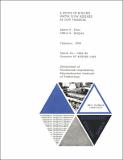A study of boiling water flow regimes at low pressures
Author(s)
Fiori, Mario P.; Bergles A. E.
DownloadHTL_TR_1966_040.pdf (6.185Mb)
Other Contributors
Massachusetts Institute of Technology. Dept. of Mechanical Engineering.
Massachusetts Institute of Technology. National Magnet Laboratory.
Massachusetts Institute of Technology. Heat Transfer Laboratory.
Metadata
Show full item recordAbstract
"A comprehensive experimental program to examine flow regimes at pressures below 100 psia for boiling of water in tubes was carried out. An electrical probe, which measures the resistance of the fluid between the centerline of the flow and the tube wall, was used to identify the various flow regimes. This probe proved to be an ideal detection device, because of its simplicity, reproducibility, and accurate representation of the flow pattern within the heated test section. The major flow regimes observed were bubbly, slug and annular flow. Under certain conditions at high flow rates, a wispy-annular flow patern was observed. The effects of mass velocity (0.2 x 10 - 2.4 x 100 lbm/hr-ft2), inlet temperature (100, 150, 2000F), exit pressure (30, 100 psia), quality (x = -10 - +7 percent), purity (9, 40 PPM NaCl; 1-3 megohm-cm), length (L/D-30, 6Q, 90), diameter 0.094, 0.242 in.), and orientation (vertical and horizontal on the flow regimes were studied. Flow regime maps on coordinates of mass velocity and quality are presented for these conditions. Bubbly and slug flow occurred primarily in the subcooled region, while fully developed annular flow was reached at equilibrium qualities between 2 and 4 percent. The transitions between the different flows were shifted to regions of increased subcooling when velocity, pressure, and heat flux increased, and when inlet temperature decreased. Purity and geometry had little affect on the flow regime boundaries. (cont.) The shifting of the transitions is related to the agglomeration point, which is that point at which the bubbles so coalesce that slug flow is first observed. The agglomeration point depends on the point of incipient boiling, the number of bubbles in the flow, and the number of collisions per bubble. These latter quantities in turn depend on velocity, temperature, pressure, and heat flux. The flow regime information obtained in this study s~hould be of value in correlating and interpreting low pressure heattransfer data. The flow regime data were found to be useful in explaining the effect of inlet temperature on burnout heat flux.
Date issued
1966Publisher
Cambridge, Mass. : M.I.T. Dept. of Mechanical Engineering, [1966]
Other identifiers
14072571
Series/Report no.
Technical report (Massachusetts Institute of Technology, Heat Transfer Laboratory) ; no. 40.
Keywords
Boiling-points., Pipe -- Fluid dynamics., Heat -- Transmission.